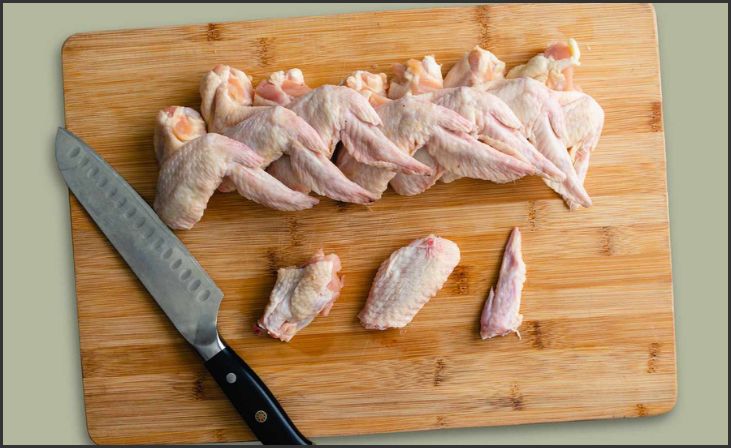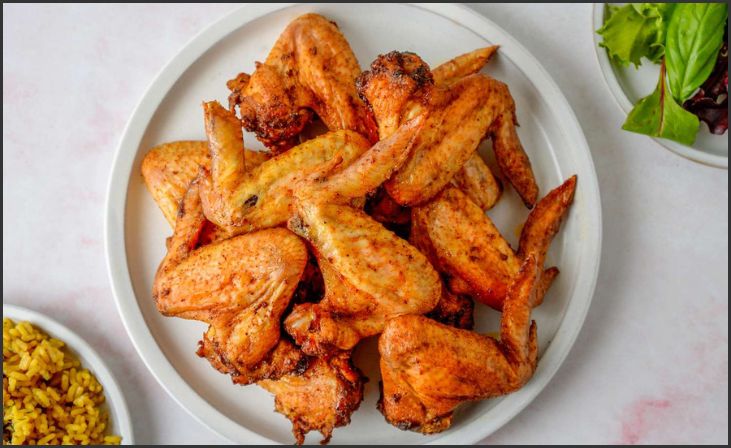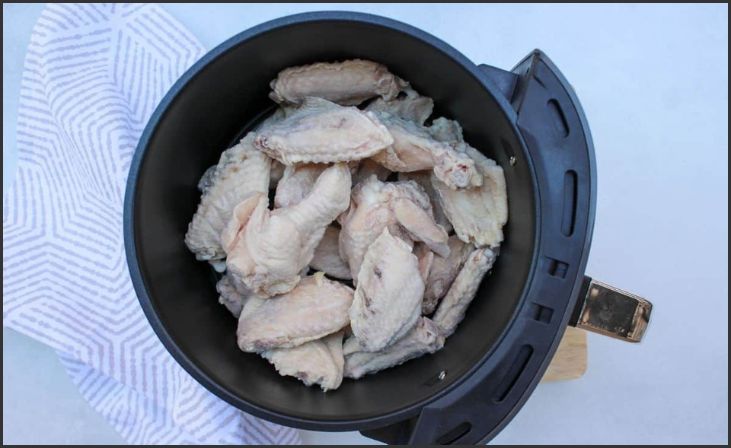Chicken wings are favorite at parties and gatherings because they are delicious and easy to prepare. However, as a cook, it’s important to know how to cut chicken wings properly, whether you like them moist and tender or with a crispy texture.
The process of cutting chicken wings is simple, but it’s crucial to use the correct techniques. In just a few minutes, you can easily separate your chicken wings into drumettes and wingettes.
So, let’s learn how to cut chicken wings!
What Are Chicken Wings

Chicken wings are a type of poultry that consists of the wing of a chicken. They are typically cut into smaller pieces and are often served as a snack or appetizer at parties or gatherings.
Chicken wings can be cooked in various ways, including grilling, frying, roasting, and slow cooking, and they can be flavored with a wide range of sauces, such as buffalo sauce and BBQ sauce, teriyaki sauce, and more.
Chicken wings are popular because they are flavorful, versatile, and easy to prepare.
Parts of Chicken Wings
A chicken wing consists of three main parts: the wingtip, the drumette, and the Wingette or flat.
The wingtip is the thin, pointed end of the wing. It is made up of small bones and doesn’t have much meat on it. Wingtips are often discarded or saved for making stock.
The drumette is the curved, drumstick-like part of the wing. It has a larger bone and more meat than the wingtip.
The Wingette or flat wing is the flat, meaty part of the wing that is attached to the drumette. It has a thin bone running through the center and is the most flavorful part of the wing.
When cutting a chicken wing, you can separate these three parts by cutting off the wingtip and then cutting the remaining wing into two pieces at the joint where the wing bone connects to the drumette. This will give you one drumette and one flat for each wing.
Why Cut Chicken Wings
There are a few reasons why you might want to cut chicken wings:
To make them easier to eat: Cutting chicken wings into smaller pieces makes them easier to handle and eat, especially when you serve them as an appetizer or snack.
To cook them more evenly: When you cut chicken wings into smaller pieces, they will cook more evenly and be less likely to overcook or burn on the outside before the inside is fully cooked.
To use in different recipes: Cutting chicken wings into smaller pieces allows you to use them in a wider variety of recipes, such as buffalo wings, BBQ wings, and more.
Overall, cutting chicken wings is a simple process that can help make them more convenient and versatile in the kitchen.
How to Cut Chicken Wings
If you love chicken wings but don’t know how to cut them, don’t worry! It’s very easy to do and only takes a few simple steps.
Here’s how to cut chicken wings:
- Start by washing your hands thoroughly with soap and water. It’s important to do this before handling any raw chicken to prevent the spread of bacteria.
- Next, gather your tools. You’ll need a sharp knife, a cutting board, and a bowl or plate to put the cut wings in.
- Place the chicken wings on the cutting board, with the wingtips pointing towards you.
- Using your knife, cut off the wingtips and discard them or set them aside for another use (such as making stock).
- Cut the remaining wing into two pieces at the joint where the wing bone connects to the drumette.
- Repeat the process with the remaining wings.
- When you are finished, wash your hands and any utensils or surfaces that came into contact with the raw chicken wings.
Now that you know how to cut chicken wings, you can use them in various recipes. Whether you’re making buffalo wings, BBQ wings, or simply roasting them in the oven, having the wings cut into smaller pieces makes them easier to handle and cook.
Sauces for Chicken Wings
There are countless sauces that can be used to flavor chicken wings. Here are a few popular options:
- Buffalo sauce: This spicy sauce is made with hot sauce, butter, and vinegar and is often used to make buffalo wings.
- BBQ sauce: A sweet and tangy sauce made with tomato paste, vinegar, sugar, and a variety of spices.
- Teriyaki sauce: A savory sauce made with soy sauce, sugar, and mirin (a type of rice wine).
- Garlic parmesan: A creamy sauce made with butter, garlic, and parmesan cheese.
- Honey mustard: A sweet and tangy sauce made with mustard, honey, and mayonnaise.
You can also mix and match these sauces or create your own custom blend to suit your taste preferences. Chicken wings are a blank canvas that can be flavored with all sorts of sauces, so get creative and have fun!
How to Cook Chicken Wings?

There are many different ways to cook chicken wings; the best method will depend on your preferences and the recipe you are using. Here are a few popular methods for cooking chicken wings:
- Roasting: Preheat your oven to 425°F (220°C). Place the wings on a baking sheet lined with parchment paper or a silicone mat. Bake for 40-45 minutes or until the internal temperature reaches 165°F (74°C).
- Grilling: Preheat your grill to medium-high heat. Place the wings on the grill and cook for 10-15 minutes, flipping occasionally, until the internal temperature reaches 165°F (74°C).
- Frying: Fill a deep saucepan or Dutch oven with oil and heat to 375°F (190°C). Carefully place the wings in the oil and fry for 10-12 minutes or until the internal temperature reaches 165°F (74°C).
- Slow cooking: Place the wings in a slow cooker with your desired sauce and cook on low for 4-6 hours or until the internal temperature reaches 165°F (74°C).
No matter which cooking method you choose, be sure to use a meat thermometer to ensure that the chicken wings are cooked to a safe internal temperature.
How do You Know When Chicken Wings Are Cooked?
Meat thermometers are best for determining chicken wing doneness. To be safe, chicken wings must be cooked to 165°F (74°C).
To use a meat thermometer, insert the probe into the thickest part of the chicken wing, making sure not to touch the bone. The thermometer should register at least 165°F (74°C) before the wings are fully cooked.
It’s important to note that the cooking time for chicken wings will vary depending on the method you are using and the size of the wings. For example, smaller wings will cook faster than larger ones, and grilling or frying will cook the wings more quickly than roasting or slow cooking.
In addition to using a meat thermometer, you can also check for doneness by looking for clear juices and a cooked appearance. The juices should run clear, and the chicken should be cooked all the way through and no longer pink.
Chicken Wings Recipes
Here are a few delicious chicken wing recipes to try:
- Classic Buffalo Wings: Combine 1 cup of hot sauce, 4 tablespoons of melted butter, and 2 tablespoons of vinegar in a large bowl. Toss 1 pound of cooked and cooled chicken wings in the sauce until they are evenly coated. Serve with blue cheese dressing and celery sticks.
- BBQ Wings: In a small saucepan, whisk together 1 cup of BBQ sauce, 2 tablespoons of honey, and 1 tablespoon of apple cider vinegar. Bring to a simmer over medium heat. Toss 1 pound of cooked and cooled chicken wings in the sauce until they are evenly coated. Bake in a preheated 425°F (220°C) oven for 10-15 minutes or until heated.
- Garlic Parmesan Wings: Melt 4 tablespoons of butter in a small saucepan. Add 4 cloves of minced garlic and cook for 1 minute. Stir in 1/2 cup of grated parmesan cheese. Toss 1 pound of cooked and cooled chicken wings in the sauce until they are evenly coated. Bake in a preheated 425°F (220°C) oven for 10-15 minutes or until heated.
- Honey Mustard Wings: In a small saucepan, whisk together 1/2 cup of honey, 1/2 cup of dijon mustard, and 1/4 cup of mayonnaise. Bring to a simmer over medium heat. Toss 1 pound of cooked and cooled chicken wings in the sauce until they are evenly coated. Bake in a preheated 425°F (220°C) oven for 10-15 minutes or until heated.
- Teriyaki Wings: In a small saucepan, whisk together 1/2 cup of soy sauce, 1/4 cup of sugar, and 2 tablespoons of mirin. Bring to a simmer over medium heat. Toss 1 pound of cooked and cooled chicken wings in the sauce until they are evenly coated. Bake in a preheated 425°F (220°C) oven for 10-15 minutes or until heated.
Storing and Reheating Chicken Wings
If you have leftover cooked chicken wings, you can store them in the refrigerator for up to four days or in the freezer for up to three months.
To store cooked chicken wings in the refrigerator, place them in an airtight container or wrap them tightly in plastic wrap or aluminum foil.
To store them in the freezer, wrap them in plastic wrap and then place them in a freezer-safe bag or container.
When you are ready to reheat the chicken wings, there are a few different methods you can use:
- Oven: Preheat your oven to 350°F (175°C). Place the wings on a baking sheet lined with parchment paper or a silicone mat. Bake for 10-15 minutes or until heated through.
- Grill: Preheat your grill to medium heat. Place the wings on the grill and cook for 5-7 minutes, flipping occasionally, until heated through.
- Microwave: Place the wings in a microwave-safe dish and cover them with a damp paper towel. Heat on high in 30-second intervals until heated through.
No matter which method you choose, be sure to check the internal temperature of the chicken wings to ensure that they have reached at least 165°F (74°C) before serving. This will ensure that they are safe to eat.
Is it necessary to remove the skin from chicken wings before cooking them?
It is not necessary to remove the skin from chicken wings before cooking them, and in fact, many people prefer to leave the skin on for added flavor and texture. However, there are a few reasons why you might want to remove the skin:
- To reduce the fat content: Chicken skin contains a significant amount of fat, so removing it can help reduce the overall fat content of the dish.
- To reduce the risk of food poisoning: Chicken skin can harbor bacteria, so removing it can help reduce the risk of food poisoning.
- To reduce the risk of fire: If you grill chicken wings, leaving the skin on can increase the risk of flare-ups and charring.
Ultimately, whether or not to remove the skin from chicken wings is a personal preference. Some people prefer the taste and texture of skin-on wings, while others prefer skinless wings for health or safety reasons.
Can you put raw chicken wings in an air fryer?

It is possible to cook raw chicken wings in an air fryer, which is a convenient and efficient way to produce crispy, flavorful wings with less oil than traditional frying methods.
To cook raw chicken wings in an air fryer:
- Preheat the appliance to 400°F (200°C) and place the raw wings in the basket in a single layer.
- Cook for 15-20 minutes or until the internal temperature of the chicken reaches at least 165°F (74°C). The cooking time may vary based on the size and thickness of the wings and the specific air fryer model.
- Remember to use a meat thermometer to ensure the wings are fully cooked before serving.
Conclusion
Mastering the art of cutting chicken wings is a valuable skill that elevates your culinary expertise. From choosing the right tools to experimenting with different cuts and styles, each step contributes to a delightful chicken wing experience. Whether you’re a seasoned chef or a home cook, these tips will help you create mouthwatering wings that impress and satisfy.
FAQs
While fresh wings are preferred, you can use frozen wings with proper thawing before cutting.
Store leftover wings in an airtight container in the refrigerator for up to three days. Reheat in the oven for optimal crispiness.
Yes, kitchen shears are a suitable alternative for cutting chicken wings, providing precision and control.
Yes, you can explore plant-based alternatives like cauliflower wings for a vegetarian option.

Leave a Reply